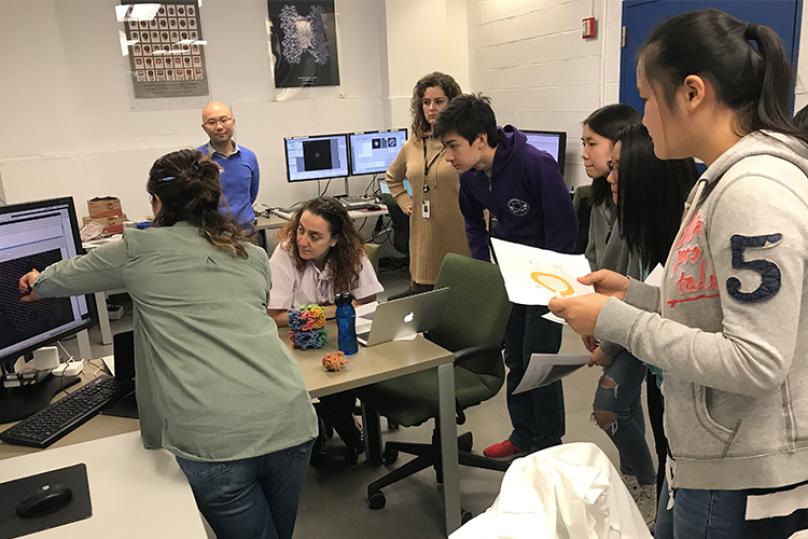
“If you’re interested in biology, chemistry, physics, any kind of science, you’ll have many options when you prepare for your future."
- Stuyvesant High School student
Last month MƒA Master Teacher Marissa Maggio and 60 of her freshmen AP biology students toured the New York Structural Biology Center (NYSBC), an organization of nine eminent academic research institutions and the global leader in structural biology, to learn about the center after first being introduced to the idea at MƒA.
This past fall Marissa participated in the MƒA multi-session course “First-Hand Exposure to Spectroscopy and Microscopy Techniques,” which took place at the NYSBC. The goal of the course was for MƒA teacher participants to both learn about the work done at the center and form working relationships with the NYSBC staff.
After the course was completed and when offered the opportunity, Marissa jumped at the chance to bring her students on a field trip to the center. Marissa was eager to introduce her students to NYSBC’s research, expertise, and state-of-the art equipment in the fields of NMR spectroscopy, X-ray crystallography, electron microscopy, and protein production. And because of the connection she made with the center as part of her MƒA fellowship, she was able to coordinate a fun and informative visit, the first of its size the center has ever held. All scientists at the NYSBC stopped work for the day and devoted themselves to the MƒA field trip for students.
“During the fall MƒA course at the NYSBC, I had this moment where I had just finished using the Scanning Electron Microscope to examine the hairs on the leg of an ant and knew my students would love the chance to do the same thing,” said Marissa. “High school students very often have an inaccurate image of what working in a lab is like, and through this trip we were able to shine a light on the different academic fields that work together to successfully operate one.”
“This tour was a hands-on dive into structural information, where students investigated what the body’s molecular machines look like and learned how they work,” said Willa Appel, Ph.D., Executive Director of NYSBC. “Being exposed to a serious scientific environment helped many of them appreciate that there are lots of exciting career choices if you are interested in biology and math.”
During their excursion to the NYSBC, Marissa and her students were introduced to some of the concepts and experimental methods used by structural biologists to understand “molecular machines,” the biological complexes that carry out multiple functions within our cells. They met lab technicians, computer programmers, software developers, and visiting researchers from universities across the country. They broke into small groups and journeyed to a number of different working stations which provided opportunities like exploring cell culturing rooms, learning more about bacterial expression analysis, and having fun with liquid nitrogen.
As the day concluded, students were able to pinpoint why structure is so important to them. Marissa added, “Many times, students ask, ‘How do we know this is happening? How can we see these structures?’ This tour helped cement in their minds the answers to these questions.” Marissa said she feels very fortunate that MƒA was able to offer this course that led to an opportunity to expand her students understanding of structural biology. “I’m grateful to MƒA for giving us these connections and to the staff of the NYSBC for taking the time to share what and why they do what they do with these curious, developing minds.”